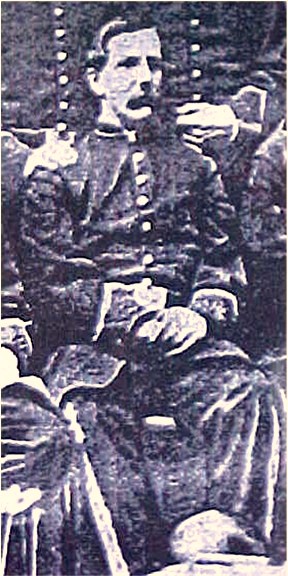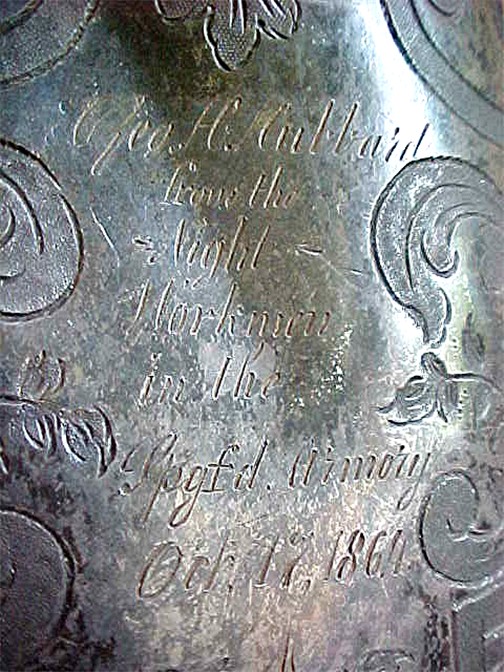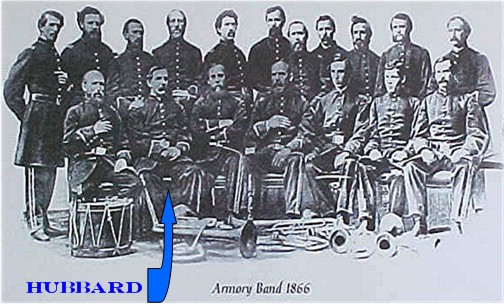|
1864 DATED
SPRINGFIELD ARMORY PRESENTATION PITCHER – PRESENTED TO
SHOP FOREMAN & ARMORER GEORGE H. HUBBARD BY HIS WORKMEN
– VERY RARE NATIONAL ARMORY HISTORICAL PIECE: A
very rare historical artifact, this heavily engraved
pitcher was presented during the Civil War, on October
17, 1864, by workers at the National Armory at
Springfield, Massachusetts to one of the shop foremen,
Armorer George H. Hubbard.


George H. Hubbard was born in 1828 into a Springfield
family of gunsmiths and machinists, so it was a natural
evolution that he sought employment at the National
Armory at Springfield. He spent the majority of his
working life at the armory, with the exception of a
short period when he lived in New Haven, Connecticut,
working at the Winchester Repeating Arms Company.
Copies of select Springfield Armory pay records
beginning in 1859 were located which reflect Hubbard’s
employment, first as a piece worker milling and
finishing sling swivels and, according to his obituary,
eventually being promoted to Shop Foreman during the
Civil War. Several census records list his employment
as “US Armorer”, as do the Springfield City Directories
of the 1860’s.
Given the years of Hubbard’s service, it gives one pause
to consider the development and production of so many of
the key models of Springfield Arms which crossed his
work bench and were finished by the workmen under his
supervision. These men were not merely witnesses to the
history written within the walls of the Armory; rather
they wrought that history through the power of their
spirit and skill in their hands.
While no specific incident or event could be located in
the local Springfield records to attribute to the date
of the presentation described on the pitcher, Hubbard’s
importance in the Springfield community was well
documented during his life. Recognized as an
accomplished musician, Hubbard founded, and led, the
Springfield Armory Band, and was known for his musical
arrangements for the band and for other orchestras with
which he was associated. In fact, the only photograph
of Hubbard that we could locate was of him seated with
the Armory Band in 1866. His reputation as a musician
was such that one newspaper headlined his obituary with
“WELL KNOWN MUSICIAN [Dies], rather than a banner
acknowledging his years of service at the armory. Due
to his reputation as a musician, I suspect the
presentation of this pitcher was somehow related to the
Armory Band.

The United States Census of 1900 recorded Hubbard still
living in Springfield and apparently retired. Hubbard
remained an active and well known resident of the city
until his death in 1907 at the age of 78. As late as
1896, in reporting on a Militia basketball tournament,
the March 3RD edition of the Worcester (MA)
Daily Spy wrote that “Armorer” George Hubbard was
offering an “elegant” silver punch bowl and ladle as the
trophy – evidence not only of his civic involvement, but
also that the practice of using “silver” presentation
pieces was still in vogue.
The significance of this presentation to Armorer Hubbard
is evident as the workman obviously purchased the
highest quality and greatest extent of engraving their
meager salaries would allow. The pitcher is engraved
with three broad bands of detailed floral designs – each
a different pattern than the other two. The engraving
was very well executed by a skilled hand, with each
leaf, flower, and scroll highlighted with considerable
fine detail and much of it is executed in relief.
The floral patterns
terminate on the front of the pitcher below the spout
and in the resulting open space is engraved the
presentation legend,
Geo.
H. Hubbard
from
the
Night
Workmen
in the
Spgfd.
Armory
Oct. 17, 1864.
Fashioned with a gracefully executed spout and handle,
the pitcher also has a hinged lid formed with concentric
rings.
The exterior of the pitcher has
naturally aged from the original bright silver to a deep
blued patina that has been left undisturbed. The
interior of the pitcher, and the underside of the lid,
both retain the original bright polished silver finish,
and the exterior of the pitcher could be polished out as
well, if the new owner so desired. There are four dents
in the exterior as can be seen in the photos below and
again, a professional silver smith could probably
eliminate these if you so choose, but as they present,
they do not detract from the overall appearance of the
pitcher. All of the seams are solid with no breaks,
splits or weak points.
Measuring 11 ½” tall and 7 ¼” across the base, this
impressive pitcher is manufactured of Britannia metal
(also called britannium or Britannia ware),
a pewter-type alloy favored for its silvery appearance
and smooth surface, and composed of (approximately and
typically) 92% tin, 6% antimony, and 2% copper. Dating
from as early as 1769,
Britannia has been used for making various
utensils including teapots, jugs, drinking vessels,
candlesticks, and urns, and for official maces. Similar
in color and feel to traditional pewter, but lacking the
dangerous lead component, Britannia metal is harder,
stronger, and easier to work than other tin alloys in
that it can be worked from sheets like silver, or spun
on a lathe, and in the mid-19TH Century,
Britannia metal pieces had gained popularity as an
affordable “working man’s” silver service.
While the pitcher lacks any maker’s identification mark,
the distinctive features, particularly the shape and
style of the handle and the spout, are consistent with
other similar pieces which are attributed to mid-19Th
Century American silver and metal smiths. The size of
this piece, and the positioning of the spout high on
side, is consistent with other pitchers identified as
water or milk pitchers – a serving vessel which would
have been present on any well appointed table of the
period.
I won’t belabor the obvious rarity or historical
significance of a Springfield Armory presentation piece
nor the unlikelihood that such a piece is offered on the
collector’s market. This would be a “one-of-a-kind”
addition to any collection of Springfield arms, or a
collection of Civil War identified pieces, and in either
case, is a piece with few, if any, peers. A binder with
all of the research, genealogical records and
photographs which was gathered for George H. Hubbard,
the Armory, and his residences in the City of
Springfield will be included in this sale. (0012)
$3000
|

